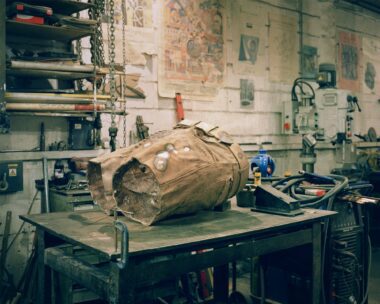Design Elevate your designs through the beauty of screen printing

[ad_1]

Executed with just the right blend of passion, craft and expertise, silkscreen printing techniques can take a piece of creative work to new heights of desirability and multi-sensory appeal. It’s satisfying to touch, evocative to smell and beautiful to behold.
“I love its simplicity and directness,” enthuses Swiss screen printing specialist Lorenz Boegli. “It’s perhaps the printing process that allows the most personality. Thanks to its flexibility and technical breadth, it can emphasise a graphic designer’s ideas through the creative production process.”
For a recent project to showcase Antalis’ new eco-conscious paper range Olin Origins, for instance, Boegli teamed up with a regular collaborator – photographer Rob Lewis – to express the ‘origins’ theme in an abstract way: juxtaposing generation-spanning portraits of grandparents and grandchildren with geological images of the surface textures of rocks.
“These are extreme time-lapses: 60 years between boy and grandmother, and close to 60 million years for rocks in the Swiss Alps,” Boegli adds. “And somewhere in between, there’s the life cycle of Olin Origins paper.”
THINK MORE SUSTAINABLY
Designers are now spoiled for choice with eco-conscious paper options: “There’s such an extensive range of partially or fully recycled design papers,” confirms Boegli. “They can come in beautiful colours and are technically so well produced that they have the same whiteness as virgin fibre papers.”
Olin Origins is one such stock, and a favourite in Boegli’s toolkit: “It has a unique, open-surface texture that makes it feel very soft,” he says. “This makes for a great contrast with the feel of a glossy foil, for instance, or a relief ink deposit.”
Boegli had free rein to express the ecological message at the heart of range, doing Lewis’ images justice through the craft of screen printing. Inspired by the raw materials of our planet, he used all-natural pigments made from coloured earths – finding, in the process, both a harmonious palette and a distinctive texture to contrast the softness of the stock.
“These include ochre from southern France, umbra from central Italy, black earths from Andalusia, earths from Cyprien and green earth from Bohemia, and a slate grey lime from the Alps,” he reveals. “We took into account colour tones of the different coloured earths in the separation, and again included the paper itself as another colour tone in the design.”
As a carbon-neutral range, Olin Origins also fits into Boegli’s wider vision for sustainable production. His print shop is entirely powered by photovoltaic electricity, generated on a farm a short cycle ride away. He produces the hot water to develop his stencils on the roof of his plant and uses natural methods – including minerals and fleeces – to clean the resulting wastewater.
ADD PAPER TO YOUR PALETTE
Inspiration for a new creative concept or printing effect often starts with the paper stock. “My aim is to integrate paper into design as more than just an image carrier,” says Boegli. “When this succeeds harmoniously, I believe paper and print combine to touch the soul through the eye. One plus one equals three.”
Exploring the full potential of each stock – such as colour, grammage, surface or technical properties – can spark off unexpected creative possibilities. When choosing a paper, Boegli is partial to unusual colour palettes not found elsewhere on the market: Keaykolour from Arjowiggins is a long-running favourite.
Another recent project involved screen printing onto a medium grey Keaykolour paper, and then using that background colour to dramatic effect in the design. “One shade was positive screen printed in black; the colour of the unprinted paper made up the 3/4 tones; and then we used a further three negative print passes with lighter colours to white,” explains Boegli. “Integration of paper colour tone gave the work an extraordinary dimensionality.”
Different grammages can also create a striking contrast that can help tell a story. “It could be a tissue paper that reduces the speed of handling, or a 700 g/m2 cardboard that looks sculptural in combination,” he adds. “You could work with transparent papers using opaque and transparent screen printing inks – or combine your paper colour tone with one opaque and one transparent colour to form four-colour combinations.”
ENHANCE THE TACTILE APPEAL
One of screen printing’s biggest creative selling points compared to other methods is its tactility and texture. “It can print the largest ink deposits; the coarsest pigments,” Boegli points out. “This allows effects to sprout like buds on a large tree in spring. It allows opacity and transparency, surfaces and finest halftone screens, tissue paper and heavy cardboard, pure colours, iridescence, and even negative on dark papers.”
One of Boegli’s hallmark techniques involves printing the reflections of light on an object or scene instead of the colours, producing an ethereal, luxurious finish. “I am known as the black paper printer,” he says. “I mislead the eye, reproducing photographs negatively on dark papers with iridescent or metallic pigments.”
Boegli began using iridescent pigments in halftone images in the late 90s, and the lessons learned from this process would later help him develop an innovative RGB approach to screen printing fine raster images. By printing red, green and blue ink on black paper, he created an additive four-colour process – now patented in partnership with Merck.
“Choosing paper is a creative act,” Boegli concludes. “Even a simple coloured paper, printed in two colours and cleverly folded, can convey a graphic idea or message. But if it gets more complex, be sure to choose your production partners early. That way, the possible effects can support your idea and be incorporated into the design – not just decorate the surface.”
Discover the making of Lorenz Boegli’s Olin Origins project here and keep in touch with Olin by Antalis on Instagram; instagram.com/olin_paper
[ad_2]
Source link





